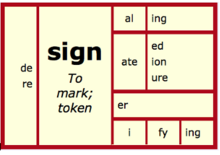Structured word inquiry
| Part of a series on |
| Reading |
|---|
 |
Structured Word Inquiry (SWI) is a pedagogical technique involving the scientific investigation of the spelling of words.[1][2][3] SWI considers morphology,[4][5] etymology, relatives, and phonology.[3][6] The guiding principles of SWI are (1) "the primary function of English spelling is to represent meaning"[7] and (2) "conventions by which English spelling represents meaning are so well-ordered and reliable that spelling can be investigated and understood through scientific inquiry."[6][8][9]
Four questions
[edit]SWI uses four questions to investigate the spelling of a word:[6][10]
- What is the meaning of a word?
- What are the morphemes of the word?
- What are morphological and etymological relatives of the word?
- What are the letters doing in the word (spelling phonemes, functioning as markers, zeroed)?
The questions must be investigated in order starting with the meaning.
Word sums
[edit]A word sum shows how a word is built.[10][11] A word sum is a "necessary tool to allow falsification of hypotheses of orthographic morphological structure."[3][6]
The following are examples of word sums:
- de + sign -> design
- de + sign + ate + ed-> designated
- sign + al -> signal
- sign + ate + ure -> signature
- re + sign + ate + ion -> resignation
Word Matrices
[edit]A word matrix is a visualization of the morphology of related words.[10][6][11]

References
[edit]- ^ Bowers, Peter (11 November 2019). Teaching How the Written Word Works.
- ^ Cooke, Gina (22 April 2019). "OG, SWI, and Other Acronyms". Linguist-Educator Exchange. Retrieved 19 July 2020.
- ^ a b c "What Is Structured Word Inquiry?". Nueva Teach. Retrieved 19 July 2020.
- ^ Bowers, Peter N.; Kirby, John R.; Deacon, S. Hélène (June 1, 2010). "The Effects of Morphological Instruction on Literacy Skills: A Systematic Review of the Literature". Review of Educational Research. 80 (2): 144–179. doi:10.3102/0034654309359353. S2CID 146237965.
- ^ Bowers, Peter N.; Cooke, Gina. "Morphology and the Common Core Building Students' Understanding of the Written Word" (PDF). Retrieved 19 July 2020.
- ^ a b c d e Bowers, Susan; Bowers, Peter. "Understanding SWI: "Structured Word Inquiry" or "Scientific Word Investigation"". WordWorks Literacy Centre. Retrieved 19 July 2020.
- ^ Martin, Nancy. "Struct +ure/ +ed Word + Inquire/ +y (SWI)". Eagle Hill School. Retrieved 21 July 2020.
- ^ "Structured Word Inquiry". The Reading and Learning Clinic of Manitoba. Retrieved 19 July 2020.
- ^ Bowers, Jeffrey S.; Bowers, Peter N. "The importance of correctly characterising the English spelling system when devising and evaluating methods of reading instruction: Comment on Taylor, Davis, and Rastle" (PDF).
- ^ a b c Kosur, Heather Marie. "Structured Word Inquiry". Teach a Student to Read. Retrieved 19 July 2020.
- ^ a b Ramsden, Neil. "Mini Matrix-Maker Home Page". Neil Ramsden. Retrieved 19 July 2020.
